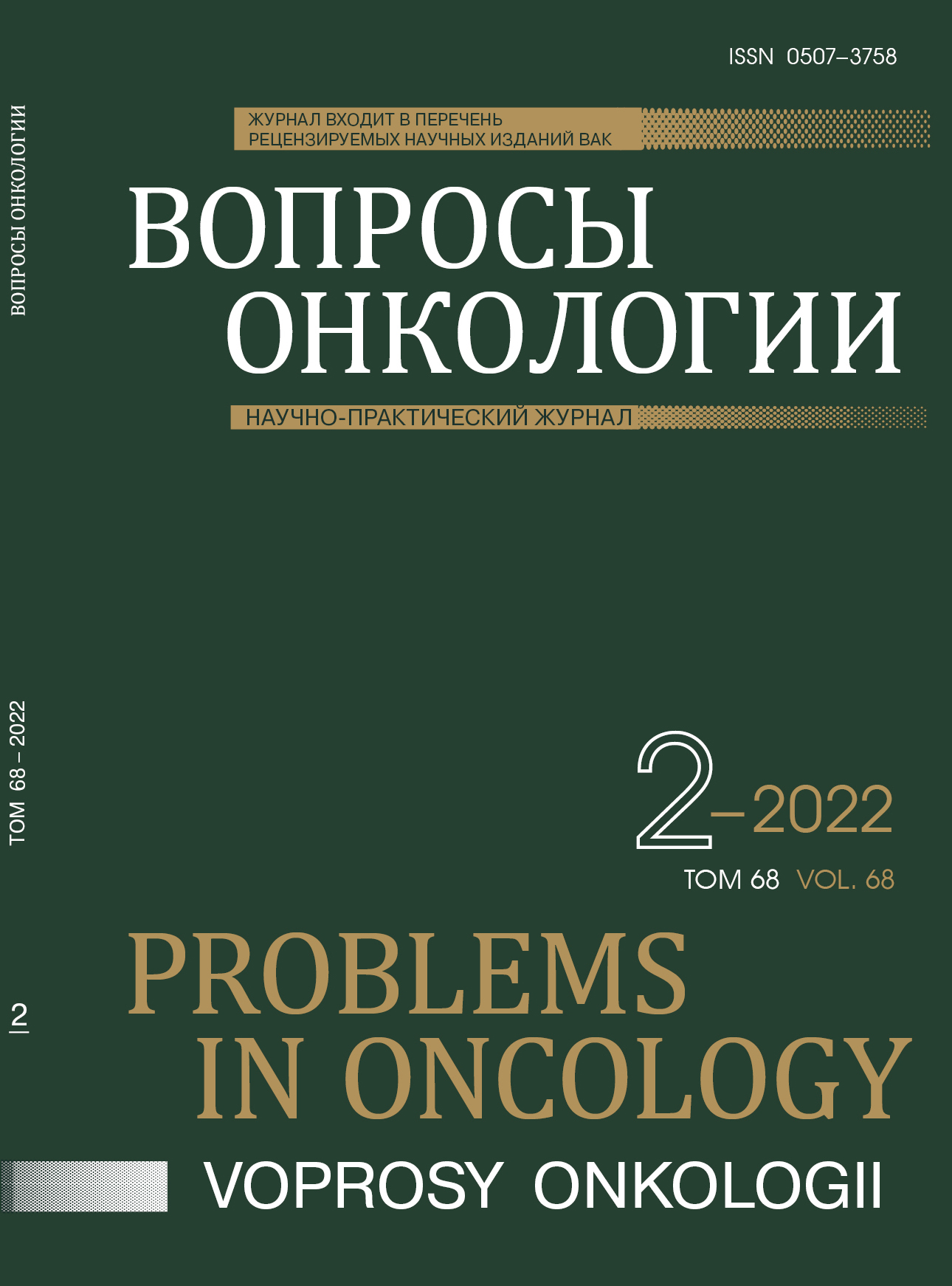Abstract
Aims. To improve the results of surgical treatment of patients with tumor diseases of the pancreatoduodenal zone.
Materials and methods. The cohort study included 94 patients with tumor diseases of the pancreatoduodenal zone who underwent pancreatoduodenal resection in 2014–2019. All patients belonged to the category of resectable and borderline resectable. Two groups of patients were formed. II (comparison group) — patients who received treatment in 2014–2017 (n=49). In this group of patients, the risk of developing postoperative pancreatic fistula was not calculated and the choice of the technique for the formation of pancreatoenteroanastomosis was carried out depending on the preferences of the operating surgeon. I (main group) — patients who were treated in 2018–2019 (n=45). In this group of patients, the choice of the technique for the formation of pancreatoenteroanastomosis was carried out in accordance with the developed algorithm, depending on the risk of postoperative pancreatic fistula development, and also, according to indications, a new method of reservoir terminolateral pancreatojejunostomy was used. A comparative analysis revealed the representativeness of the studied groups in terms of the main parameters (gender, age, comorbidity index, anesthetic risk, the presence of obstructive jaundice, tumor localization, stage of the disease).
Results. The use of the developed algorithm led to a significant decrease in the incidence of postoperative complications from 73.4 to 37.8% (p<0.01), postoperative pancreatic fistulas from 28.6 to 6.6% (p<0.05), postoperative pancreatitis from 32.6 to 11.1% (p<0.05) and arrosive bleeding from the intervention area from 18.3 to 2.2% (p<0.05).
Conclusions. The use of a differentiated algorithm for choosing the formation method made it possible to improve the immediate results of surgical treatment of patients suffering from tumor diseases of the pancreatoduodenal zone.
References
Кабанов М.Ю., Ханевич М.Д., Семенцов К.В., Бояринов Д.Ю. Пути улучшения непосредственных результатов панкреатодуоденальной резекции // Профилактическая и клиническая медицина. 2019;4(73):60–66 [Kabanov M.Iu., Khanevich M.D., Sementsov K.V., Boiarinov D.Iu. Ways to improve the immediate results of pancreatoduodenal resection // Profilakticheskaya i klinicheskaya meditsina. 2016;1:54-58 (in Russ.)].
Masiak-Segit W, Rawicz-Pruszyński K, Skórzewska M, Polkowski WP. Surgical treatment of pancreatic cancer // Pol Przegl Chir. 2018;90:2:40-48. doi:10.5604/01.3001.0011.7493
Siegel RL, Miller KD, Jemal A. Cancer statistics, 2016 // CA Cancer J Clin. 2016;66(1):7-30. doi:10.3322/caac.21332
Kawaida H, Kono H, Hosomura N et al. Surgical techniques and postoperative management to prevent postoperative pancreatic fistula after pancreatic surgery // World J Gastroenterol. 2019;25:28:3722-3737. doi:10.3748/wjg.v25.i28.3722
Рогаль М.Л., Иванов П.А., Ярцев П.А et al. Результаты выполнения панкреатодуоденальной резекции в специализированном отделении многопрофильного стационара // Неотложная медицинская помощь. 2016;1:54-58 [Rogal' ML, Ivanov PA, Yartsev PA et al. Results of performing pancreatoduodenal resection in a specialized department of a multidisciplinary hospital // Neotlozhnaya meditsinskaya pomoshch'. 2016;1:54-58. (in Russ.)].
Olakowski M, Grudzińska E, Mrowiec S. Pancreaticojejunostomy — a review of modern techniques // Langenbeck's Archives of Surgery. 2020;405:13–22. doi:10.1007/s00423-020-01855-6
Pedrazzoli S. Pancreatoduodenectomy (PD) and postoperative pancreatic fistula (POPF) // Medicine. 2017;96(19): e6858. doi:10.1097/MD.0000000000006858
Yunxiao L, Ting L, Yunxiao C et al. Pancreaticojejunostomy Versus Pancreaticogastrostomy After Pancreaticoduodenectomy: An Up-to-date Meta-analysis of RCTs Applying the ISGPS (2016) Criteria // Surg Laparosc Endosc Percutan Tech. 2018;28:139–146.
Yao L, Yang L, Ling W, Ci-Jun P. Predictive value of drain pancreatic amylase concentration for postoperative pancreatic fistula on postoperative day 1 after pancreatic resection // Medicine. 2018;97:38. doi:10.1097/MD.0000000000012487
Takehiko H, Chihiro U, Masataka A et al. The attenuation value of preoperative computed tomography as a novel predictor for pancreatic fistula after pancreaticoduodenectomy // Surgery Today. 2018;48:598–608. doi:10.1007/s00595-018-1626-y/
Ducreux M, Sa. Cuhna A, Caramella C et al. Cancer of the pancreas: ESMO Clinical Practice Guidelines for diagnosis, treatment and follow-up // Annals of Oncology. 2015;26(Supl. 5):56-68. doi:10.1093/annonc/mdv295
Callery MP, Pratt WB, Kent TS et al. A prospectively validated clinical risk score accurately predicts pancreatic fistula after pancreatoduodenectomy // J Am Coll Surg. 2013;216(1):1-14. doi:10.1016/j.jamcollsurg.2012.09.002
Miller BC, Christein JD, Behrman SW et al. A multi-institutional external validation of the fistula risk score for pancreatoduodenectomy // J Gastrointest Surg, 2014;18(1):172-79. doi:10.1007/s11605-013-2337-8
Сигуа Б.В., Земляной В.П., Захаров Е.А., Цикоридзе М.Ю. Патент 2741376 МПК А 61В 17/00; А 61В 17/11. Способ формирования резервуарного инвагинационного панкреатоеюноанастомоза. 2021. Доступно по: https://patenton.ru/patent/RU2741376C1. Ссылка активна на 29.07.2021 [Sigua BV, Zemlyanoi VP, Zakharov EA, Tsikoridze MYu. Patent 2741376 MPK A 61V 17/00; A 61V 17/11. Method of formation of reservoir invagination pancreatoejunoanastomosis. 2021. Available by: https://patenton.ru/patent/RU2741376C1 . The link is active on 29.07.2021. (in Russ.).]

This work is licensed under a Creative Commons Attribution-NonCommercial-NoDerivatives 4.0 International License.
© АННМО «Вопросы онкологии», Copyright (c) 2022
